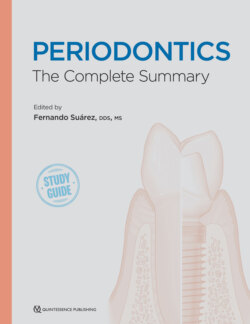Читать книгу Periodontics - Fernando Suarez - Страница 106
На сайте Литреса книга снята с продажи.
CEMENTAL TEARS
ОглавлениеCemental tears are defined as a specific type of root surface fracture and characterized by the detachment of a cemental fragment.2 Cemental tears are a rare condition able to induce periodontal attachment loss167–176 and periapical tissue destruction.177–179 Partial or complete separations can occur along the dentin-cement junction or following cementum incremental lines from both exposed and unexposed root surfaces leading to cemental tears.39,180,181
The occurrence of these cemental defects remains unclear due to its rarity. Retrospective data from a multicenter study in Taiwan reported that cemental tears are more likely to occur in mandibular and maxillary incisors (76.1%), among men (77.5%), and in patients older than 60 years (73.2%).177 A predisposition for these tears in a Hindu population has also been reported.180,182
Müller and Zander hypothesized that the occurrence of cementum defects could be associated with the quality of cementum rather than differences in rate, speed, or lack of cementum deposition.182 Conversely, Moskow noted that these defects were located mostly at the coronal third of the cementum, serving as susceptible sites for calculus formation.39 Interestingly, he pointed out that cemental tears could be the result of inadvertent root gouging during mechanical instrumentation. Additionally, observations from Leknes et al noted that cemental tears can occur away from the gingival sulcus, suggesting that these fractures can elicit a rapid periodontal breakdown in noninfected environments.167 Hence, cemental tears can often be associated with traumatic occlusion or traumatic events.2,167,181,183–188
Cemental tears are detectable clinically via very localized deep pocketing and radiographically (about 50% of the cases) with a localized radiolucency surrounding a “prickle-like body.”170,177,185 Further analysis showed that teeth with cemental tears were more likely to develop an abscess and be associated with pockets greater than 6 mm, a positive vitality test, healthy opposing teeth, and moderate to severe attrition.177
If properly diagnosed, teeth with cemental tears can be satisfactorily treated. Treatment includes removal of the cemental tear, root debridement, pocket reduction, and/or regenerative procedures with or without endodontic therapy.189 A recent study showed that most of the teeth with cemental tears could be treated via surgical or nonsurgical treatments; however, teeth with cemental tears in the apical third had a worse prognosis.190
